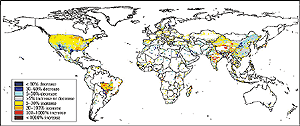
Figure 4-3: Relative change of annual net irrigation requirement between present time (1961–1990) and 2025 as a result of climate change (MPI climate scenario; areas equipped for irrigation in 1995 shown) (Döll and Siebert, 2001).
Figure 4-2 shows estimated total water withdrawals, by sector, from 1900 to 1998 (Shiklomanov, 1998; Shiklomanov et al., 2000). Agricultural use—primarily for irrigation—is by far the largest proportion, accounting in 1995 for 67% of all withdrawals and 79% of all water consumed. Municipal, or domestic, use represents only about 9% of withdrawals. There are large differences, of course, between continents, with the greatest absolute volume of irrgation withdrawals in Asia.
Over the past few years there have been many projections of future water withdrawals; virtually all have overestimated the actual rate of increase (Shiklomanov, 1998). Figure 4-2 also shows projected total global water withdrawals estimates made for the UN Comprehensive Assessment of the Freshwater Resources of the World (Raskin et al., 1997). The central projection represents a “Conventional Development Scenario” (CDS), with “best-guess” estimates of future population growth, economic development, and water-use intensity. The upper and lower lines represent high and low cases, where the assumed rates of growth are altered. Under the core CDS, global water withdrawals would increase by about 35% over 1995 values by 2025, with low and high estimates of 23 and 49%, respectively. The greatest rates of growth are projected to be in Africa and the Middle East, with the lowest growth in developed economies. These projections are very dependent not only on the assumed rate of population growth but also on the different assumed rates of water usage. They do not take potential climate change into account.
The amount of municipal water withdrawals is dependent on the number of urban dwellers, the level of development (related to the availability of a piped distribution network and sewage systems, amongst other things), income levels, and price where actually applied to water. Per capita withdrawals in many developed countries are falling, and this may more than offset an increasing population: Total municipal withdrawals in the United States, for example, are falling largely as a result of increasing prices, conservation education provided by water utilities, and increasing use of water-efficient appliances. However, municipal withdrawals in developing countries can be expected to increase with living standards; under the CDS, per capita withdrawals in these countries are projected to rise toward those in more economically developed countries. Rapid urbanization in developing countries is expected to lead to very substantial increases in total municipal water withdrawals.
The industrial sector currently accounts for approximately 20% of current withdrawals. This water is used primarily either in processing (food processing or heavy industry) or for cooling; the relative proportions vary between countries. Future industrial water use is expected to rise substantially as industrial development continues, but the increase probably will be less than the increase in industrial production as water is used with greater efficiency (using less per unit of production, for example, or relocating power generation plants to coastal areas to use seawater for cooling). Under the CDS, total industrial water use increases; this increase is concentrated largely in Asia and Latin America (Raskin et al., 1997).
The amount of water used for agriculture is dependent primarily on the level of irrigation development, the pricing of water, and the reliability of supply. Future irrigation uses are a function of the rate of expansion of irrigated land, irrigation efficiency, and pricing practices. Efficiency is projected to improve—partly as a result of changes in the cost of water and partly as a result of technological developments—but this may be more than offset by increases in the area under irrigation. The amount of increase, however, is very uncertain; it depends on, among other things, assumed rates of population growth (increasing demand) and assumed changes in world agricultural markets. Previous estimates of future water use have tended to overestimate the rate of increase because the rate of expansion of irrigated land has been overestimated (Shiklomanov, 1998). The expanded use of pricing to reflect water scarcity is being strongly promoted by international organizations and will affect the quantities used. However, many regions that historically have been dependent on rainfall are using supplemental irrigation—a factor that will increase irrigation use.
Estimates of future water withdrawals are notoriously uncertain, largely reflecting uncertainties in the future rate of population and economic growth. There is an analogy here with GHG emissions scenarios. Also important, however, are possible changes in the way water is priced. Much agricultural water, for example, currently is heavily subsidized, and a shift toward a more “economic” price for water is likely to have a very significant effect on use. The World Bank and other economic development agencies are pushing for major reforms in the way water is priced and sold, as well as the use of water markets as an efficient way of reallocating existing supplies and motivating efficiency.
|
Other reports in this collection |